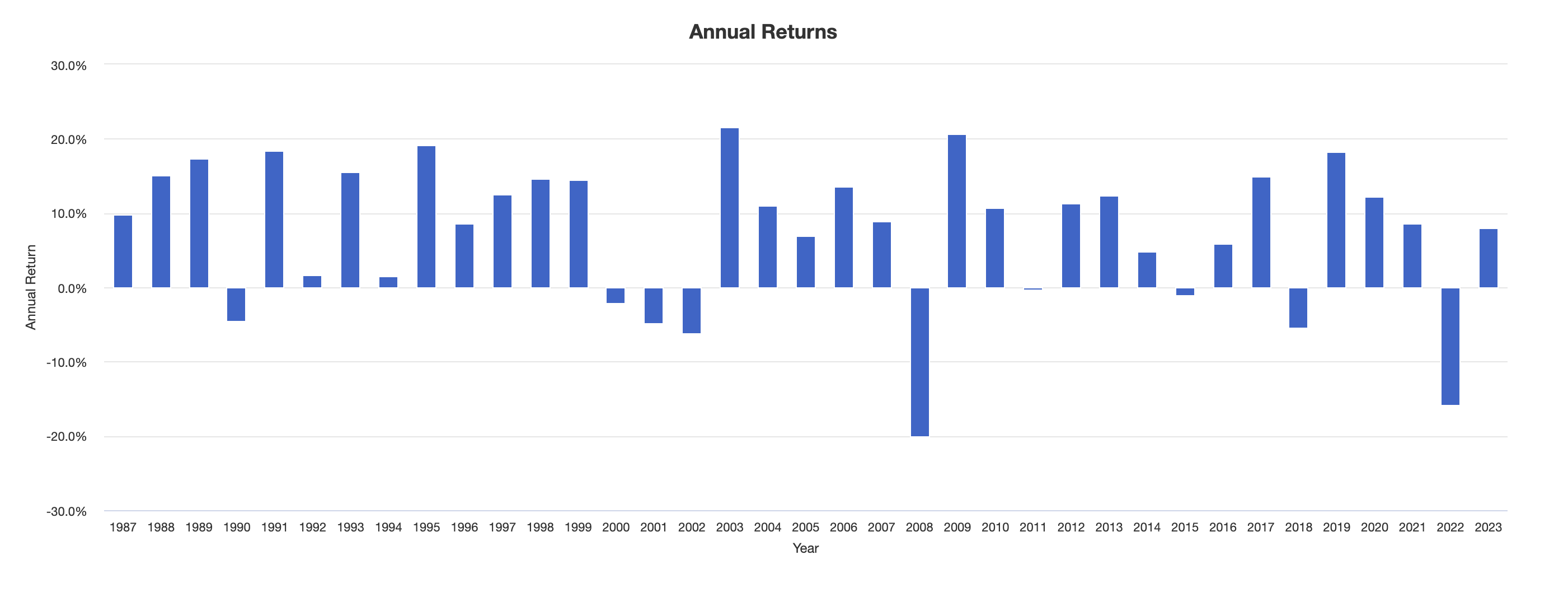
Debunking Myself (and Other MBCBP Clarifications)
Recently I wrote a post about the proposed Market-Based Cash Balance plan (here). Since that time, I’ve had countless hours of conversation about the plan and the Tentative Agreement (TA) in general. I’m sure you are in the same boat. My goal in that post and in all my subsequent conversations was and is to make sure that pilots have as much accurate information as possible to make what is a very big decision with long term consequences.
In that vein, my first order of business in this post is to correct one material error from the original post. I stated incorrectly that the interest crediting rate was a variable rate and that the mechanism for determining that rate was independent of the underlying assets. Since that writing, I have learned that this is not a correct understanding of how this plan is designed. Rather, the interest credit is based on, and indeed a direct reflection of, the actual return of the underlying assets. So rather than assessing the general direction of the assets in comparison to the target and deciding to tweak the interest credit up or down accordingly, the actual return of the assets will be assessed to each hypothetical account. This is important, because that means with this plan design it is absolutely possible to experience negative returns in a given year, or over multiple years.
I’ll go into more depth on what this means in a minute, but first…
You’re supposed to be an expert, you bozo, so how did you screw this up?
I’m going to do my best to blame the government here, but first I’m going to scold myself. The answer is in the name. It’s a Market-Based Cash Balance Plan. The interest credited is based on market performance. You dummy.
Now I’ll try to throw some blame at the government. You don’t pick a design for these plans from a menu. It’s more like painting what you want onto a canvas. You can start with what you are aiming to provide for the participants, and then reverse engineer a plan so that it gives you what you want. There are certain caps and restrictions, but in general there is a lot of leeway in how these plans are built. The problem is the terms used to describe features of these plans are vague and can create some ambiguity. That ambiguity is helpful when you are designing a plan, but very unhelpful as it turns out when you are trying to interpret a plan design without a plan document. And it’s not a fault of the drafters of the TA language. They used acceptable terminology to describe the chosen plan design. The problem that I encountered is that I had previously pieced together through sources a general (incorrect) understanding of this part of the design. Since the TA isn’t the plan document, the language isn’t specific enough to sway me from my previous understanding.
I don’t forgive you but tell me what this means anyway.
There are some things to be aware of with this design. First, because the pilot will experience the actual results of the plan, there is no way for the company to artificially manipulate the interest credits to serve their own interests. I have heard from pilots that they are worried that the company might manipulate the interest credit down if they experience a hardship of some sort. This isn't possible with this design, and even if it was, it wouldn't be helpful. The plan is a separate trust, so the assets don't belong to the company. There is no way for them to claw back money from the trust. Also, the don't directly manipulate the interest credit rate with this design. The interest credit is derived from the return on the assets in the plan.
Next, knowing the targeted average interest rate is a good start (the target is 6.5%), but the expected volatility is key to understanding how much your actual experience could vary from the average over different time periods. Luckily, you don’t have to take a guess for this plan, because per Section 28.C.11.b, the stated volatility target is a blended portfolio of 55% All Country World Index (ACWI) and 45% Barclays Aggregate Bond Index (AGG). If you expect this portfolio to be conservative, there is likely more volatility than you realize.
For quick reference, I used freely available data from Portfolio Visualizer (portfoliovisualizer.com). You can use it if you want to see for yourself or play with different historical time periods. The iShares ACWI ETF only goes back to 2008, so to get more historical data, I used a proxy portfolio of 50% Total US stock market and 50% Global ex-US for the ACWI portion. This is reasonably similar and allows us to get data back to 1987 with this tool.
The average annual return on this portfolio since 1987 was 7.55% with a standard deviation of 8.83%. Below are the calendar year annual returns since 1987.
That’s quite a range of outcomes! The best year was a 21.5% gain while the worst year was a -20.04% loss. This isn’t the volatility of a conservative portfolio by any stretch. Next let’s look at some rolling returns since 1987.
|
Roll Period
|
Average | High | Low |
|---|---|---|---|
| 1 Year | 7.22% | 34.77% | -25.97% |
| 3 Years | 7.21% | 16.78% | -5.80% |
| 5 Years | 7.14% | 13.81% | 0.29% |
| 7 Years | 7.11% | 12.20% | 2.72% |
| 10 Years | 7.07% | 11.12% | 2.56% |
| 15 Years | 6.75% | 9.08% | 4.01% |
At the top you’ll see the best and worst consecutive 12-month periods, then the best and worst 36-month periods, and so on. What’s interesting here is that on average each holding period is pretty consistently near the target, but you could still experience some meaningful variance over a 15-year period. That’s half or more of many pilot’s careers. That certainly introduces some individual risk that doesn’t exist in the aggregate.
Let’s take this a step further. Imagine three pilots that get hired in consecutive years. Assume that they all get $30,000 per year deposited into a plan that experiences the annual returns above. They each have 20-year careers and retire, so each receives the same $600,000 in career contribution credits. Pilot 1 experiences the return period from 1987-2006, Pilot 2 experiences the period from 1988-2007, and Pilot 3 experiences the period from 1989-2009. Here are the results at the end of each career. I’ve shown a money-weighted rate of return for each pilot which reflects the internal rate of return of the cashflows for each.
| Ending Balance | Return | |
|---|---|---|
| Pilot 1 | $1,896,482 | 8.27% |
| Pilot 2 | $1,871,606 | 8.25% |
| Pilot 3 | $1,341,144 | 5.09% |
Pilot 1 and Pilot 2 were able to have roughly the same experience, but Pilot 3 had a dramatically different experience. Hello 2008! But that’s not the only problematic time period. If we run this thought experiment out a full 17 years to 2022, you can see that there is meaningful variance of the outcomes.
Is This Bad?
No! It’s not bad on its own. First, that would be a fairly balanced portfolio. It’s reasonable if your goal is to seek return while limiting volatility. That’s the target for the plan overall, and it’s probably as aggressive as it can get.
Notice too that though there is a range of outcomes, at no point in this was there a market event that erased all the gains such that the only thing the pilot received was the contribution credits. I believe that kind of event is very unlikely. The actual portfolio won't just be this mix of stocks and bond. There will be real estate, private equity, and other alternative assets that will likely help to dampen volatility below the target.
However, since this portfolio represents the stated target volatility, I think it's helpful to look at. This does introduce a different kind of risk to a FedEx pilot’s financial plan. For instance, Pilot 3 above could be expected to just roll the balance out to an IRA, reinvest, and wait for it to recover. And that would generally be the prudent move. But it’s highly unlikely that Pilot 3 is excited about investing a large lump sum in January of 2009. And not investing it would have cost Pilot 3 a big chunk of money compared to staying invested.
So, this certainly complicates things. But I don’t think it complicates things enough to change my overall opinion of the plan. I believe that considering all the other features of the plan, this is still the best alternative to the traditional Defined Benefit Plan, especially for those with a longer time horizon. However, it will be very important for each pilot to carefully examine the new risks involved and adjust accordingly.
Other Clarifications
I’ve seen a document that has been circulating called TA Issues that has some thoughts about the MBCBP. There are a few items relating to the MBCBP in there worth addressing.
First is the claim that as plan fiduciary, the company can by fiat reduce the compensation eligible to receive compensation credits. The word fiduciary carries real legal weight. Even if they could, to reduce eligible compensation to serve their own interest of cost cutting would likely be a clear breach of that duty. Making changes that affect a reduction in qualified benefit accruals is a serious problem in the eyes of the IRS. Additionally, pensionable earnings are defined in the Pilot Benefit Book. Each of the things enumerated are also considered taxable earnings/wages by the IRS. In fact, the contract also includes compensation credits on one thing that was expressly excluded as eligible before: long term disability payments. Not only is it included, but there are multipliers such that even at a reduced benefit, the pilot receives compensation credits as if they were still earning 85% of their pre-disability earnings. I don’t believe that a reduction of compensation credits is a serious risk.
Next is the claim that the benefit is “artificially” tied to the 401(a)(17) limit. This is not the case. Given that the contribution formula is tied to earnings, they CANNOT consider more than the limit. They have no choice by law if this plan is going to be considered a qualified plan. There is no way to negotiate 11% of all compensation over the cap and have it deposited into the MBCBP. But just because there is an annual limit on compensation that can be considered, that limit doesn’t govern the annual amount that can be contributed. The document rightly identifies that amount as considerably high. I covered this in my last post, but this means that rather than trying to secure cash over cap, pilots should be concerned with getting the contribution rate as high as possible. This flattening of the contributions ensures maximum possible tax deferral and is the more optimal pattern to take advantage of the time value of money.
It is true that the 401(a)(17) limit went down after the Omnibus Reconciliation Act of 1993. The act was part of a sweeping attempt to raise revenue and close the budget deficit. It happened once, and since then the limit has been essentially only inflation adjusted ever since. Is this a risk? Yes, it always will be! But in 1993 the act passed, plan designers didn’t generally sit around and accept defeat. They amended plans and reworked the numbers to hit the desired benefit accrual targets. This process is expressed in the TA. In the event of a legislative reduction in the caps, a new non-qualified plan will take effect unless and until they come up with a better idea. Contractually, the negotiating committee maintained flexibility while securing a good enough worst case. Consider a scenario where the limit gets reduced by half, like the change in 1993. Rather than being tied to a non-qualified plan, the negotiating committee has the mechanism to compel the company back to the table to try to work out a better solution. Because of the flexibility of these plans, there are many thoughtful possible solutions to that problem. But if there is no agreement on a solution, the backstop created by the non-qualified plan means pilots are still contractually guaranteed that the compensation credits cannot go down due to a reduction in the caps.
As always, my aim is not to influence votes, but to inform. You have a lot to consider as you decide how to vote, and the details of this plan are and should be material to that decision. If you have questions about how to evaluate this new plan relative to your own situation, please get in touch with us!
Nathan Harro is a CFP© professional and the founder of Centennial Wealth Group, a full-service financial planning and wealth management firm that specializes in working exclusively with FedEx pilots. For more information on this or other financial planning needs, schedule a call with us!
All information presented is collected from sources believed to be reliable, but may not be guaranteed. It is meant to provide general education and should not be considered or a recommendation to take a particular course of action. The hypothetical examples are for illustrative purposes only and should not be construed as a prediction or guarantee of actual results.


